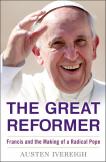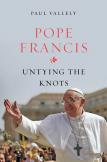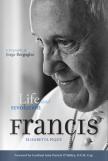From Argentina with Love
After endless news articles, interviews, and collections of the pope’s own words, is there anything new to learn about Pope Francis? The answer, as demonstrated by the sharply conflicting interpretations of his role in the Synod on the Family, is clearly yes.
For one thing, the last two papacies taught us the importance of national background. John Paul II was unmistakably the child of Poland’s struggle against two totalitarianisms. Benedict XVI was shaped by Bavarian Catholicism, the trauma of the Third Reich and the secularism of contemporary German intellectual life.
Poland and Germany, of course, were at the nerve centers of modern history. But Argentina?
Argentina entered the 20th century as one of the world’s fastest growing nations. It ended the century the underachieving victim of five military coups, the false promises of Peronist populism, a murderous campaign of kidnappings by revolution-intoxicated young people and a vastly more murderous “Dirty War” of repression by a right-wing military. Plus constant official corruption and fiscal irresponsibility.
Austen Ivereigh’s The Great Reformer fills in this Argentine background in extraordinary detail. He distinguishes, for instance, the many flavors of Peronism, a volatile mixture of nationalism, populism, demagoguery and authoritarianism that won support from Argentina’s working-class and labor unions, as well as from military personnel and Catholic social activists like the future pope.
For Elisabetta Piqué, in Pope Francis, Life and Revolution, much of this background hardly needs elaboration. Raised in Argentina and a veteran foreign correspondent for Buenos Aires’s leading newspaper, La Nación, she has known the pope since 2001. He baptized her two children. [Ed. note: She is the wife of Gerard O’Connell, America’s Rome correspondent.]
The Pope Francis she and Ivereigh portray is pretty much the one the world has come to know: spontaneous, plain-spoken, impatient with protocol and privilege, dedicated to the poor and burdened, insistent on mercy rather than inflexible judgment. Both authors underline Francis’ determination to change the church. Ivereigh in particular makes clear that Francis is no warm-hearted naïf but a politically savvy operator. His election, as Ivereigh chronicles it, did not just happen.
But make no mistake. In the crucial matter of tracing how Jorge Mario Bergoglio, S.J., became Francis, Ivereigh, backed by Piqué, tells a different story than the other major biography written in English, Paul Vallely’s Pope Francis: Untying the Knots.
There are two controversial chapters in Bergoglio’s life. The most publicized focused on his conduct during the “Dirty War.” As provincial of the Argentine Jesuits, Bergoglio ordered two left-wing Jesuits to leave their high-risk shantytown post. Did his orders (ratified by Pedro Arrupe, the Jesuits’ superior general in Rome) give the military a green light for the arrest and torture of the two priests? More broadly, was Bergoglio complicit in the Argentine church’s failure to speak out against the regime’s “disappearances,” including those of pregnant women whose babies, born in prison, were handed over to military families?
The second controversy was less morally dramatic but may have much greater implications for a Francis papacy: Bergoglio’s role at the center of bitter divisions among Argentine Jesuits. Had he led a faction that resisted the reforms of the Second Vatican Council, ignored the call of the Jesuits’ 32nd General Congregation for “action on behalf of social justice” and attacked liberation theology?
Vallely, Ivereigh and Piqué clear Bergoglio of the gravest charges of misconduct during the Dirty War. All agree that he risked himself in heroic efforts to hide and rescue people targeted by the military. But Vallely leaves an impression of some degree of moral failure, whereas Ivereigh finds the Jesuit leader’s decisions, under trying conditions, reasonable and blameless. Piqué barely has the time of day for Bergoglio’s accusers.
Regarding Bergoglio’s stance toward Vatican II and the Jesuits’ commitment to social justice, the contrast is starker. Vallely paints the future pope as a determined traditionalist. Ivereigh paints him as a proponent of “true reform” rather than “false reform,” using categories borrowed from Yves Congar, O.P., the great theologian of Vatican II. Ivereigh’s Bergoglio was deeply committed to the council and to the “preferential option for the poor”; but in overseeing the formation and education of young Jesuits, he also wanted to maintain Catholic identity and continuity with the past.
Both authors agree that Bergoglio opposed Jesuit proponents of liberation theology, but Ivereigh judges Bergoglio’s opposition as a sound rejection of an ideological current at odds with both the church and Argentine reality. When Bergoglio’s critics gained the upper hand in the see-sawing among Jesuit factions in Argentina, he was effectively exiled from influence, a break that became definitive when, to the distress of Jesuit opponents, he was appointed an auxiliary bishop of Buenos Aires.
All three authors stress how painful and humiliating Bergoglio found this rejection—he was even peremptorily and formally ordered out of Jesuit quarters while his rooms as auxiliary bishop were being prepared. Ivereigh sees this as the culmination of antagonism from Jesuit liberationists. Vallely treats it as the consequence of Bergoglio’s divisive “meddling.”
These are not small points. They add up to sharply contrasting narratives. One, Vallely’s, is essentially a story of conversion from youthful political and ecclesiastical conservatism. The other, Ivereigh’s, is essentially a story of perseverance and ultimate vindication in the pursuit of moderate “true reform.”
So, whom to believe? Francis has of course confessed that his governing “style” as a young Jesuit “had many faults.” “I made decisions abruptly and by myself”; and this “authoritarian” manner “led me...to be accused of being ultraconservative.” But “I have never been a right-winger,” he insists. This confession about “style” hardly indicates, as Vallely seems to assume, a change of heart about the substantive issues that separated Bergoglio from his adversaries.
Although these two authors cite many of the same sources, Vallely clearly gives credence to Bergoglio’s liberationist opponents within the Jesuits and to crusading Argentinians bent upon bringing to justice anyone possibly tainted by the Dirty War. Ivereigh, by contrast, gives much more credence to Bergoglio’s close associates and intimates.
If one were to judge on the basis of fuller detail and documentation, Ivereigh would win hands down. He provides footnotes; Vallely doesn’t. Ivereigh often notes political and ideological agendas of Bergoglio’s critics, of which Vallely appears unaware. Ivereigh registers the very real support Bergoglio had among younger Jesuits and the resentment this stirred among their seniors.
Personally, I find Vallely’s thesis that Bergoglio used to be one of those pre-conciliar hold-outs but now is one of us a little too self-congratulatory. On the other hand, at moments Ivereigh seems driven by the apologetic impulse (cf. George Weigel) to portray our popes (even in their pre-papal lives) as paragons of continuity and never seriously in error.
Piqué’s account falls solidly on Ivereigh’s side. In fact, it is a different sort of book, although it touches on most of the same events. A friend and enthusiastic admirer of Bergoglio from the start, Piqué is interested in illuminating his character rather than hearing out criticism. She sets scenes vividly, using the historical present tense. She makes her points with long quotations. To Vallely’s and Ivereigh’s more distanced accounts, these “insider” voices are a valuable addition. And though my life on deadline does not compare to Pique’s, her every glimpse of writing under pressure, solidarity with fellow journalists and squeezed-in moments with husband and children made the adrenaline surge again in my chest.
Both Vallely and Ivereigh warn that Pope Francis’ pastoral compassion does not necessarily mean doctrinal flexibility; but if the arc of his life is one primarily of perseverance rather than self-transformation, that is all the more significant. Ivereigh outlines Francis’ guiding principles—his rejection of “ideology” and “elite” theorizing, for example; his emphasis on unity over conflict; his appeals to popular religiosity, as well as his critique of the Enlightenment and his hewing to established positions on contraception and other questions of gender and sexuality. Many are potentially ambiguous in regard to what John Courtney Murray, S.J., declared to be the great unresolved question of Vatican II, how to understand the development of doctrine.
What happens if some of these principles collide with conclusions emerging from a genuinely collegial church—to which Pope Francis is also deeply committed? And at what point does pastoral compassion demand a reexamination or development of doctrine?
Those are the next unavoidable challenges facing “the great reformer.”
This article also appeared in print, under the headline “From Argentina with Love,” in the December 8-15, 2014, issue.










